Lead with you in media relations pieces
It’s counterintuitive, but true: The product is never the topic. The program is never the topic. The plan is never the topic. The topic is never the topic.

The reader is always the topic.
Here’s how six PR pros made the reader the topic in their PRSA Silver Anvil Award-winning campaigns.
Use the ‘Y word.’
The easiest way to write about the reader, in PR as well as in other pieces, is to use the magic word: You. That’s what PR pros did for these award-winning leads:
— Be The Match media advisory
— Vote No on 66 campaign op-ed
— State Farm Celebrate My Ride news release
Use the imperative voice.
Here’s another approach to leading with the reader: Use the imperative voice.
We learned in third grade to call the imperative voice the command voice. And it can be a command: Do the dishes. Make your bed. Clean your room.
When we use it, though, it’s the invitation voice: Grab a spade … prepare your senses … dig a little … learn a lot.
— Natural Resources Conservation Service news release
Use a placeholder for ‘you.’
I actually prefer to avoid you and the imperative voice in media relations pieces. For one thing, who’s you — the reporter or the end reader? For another, I still like to retain an objective, third-person voice in PR pieces.
The solution? A placeholder for you: Community members. New drivers. Farmers throughout the state. Teens who commit to safe driving.
That’s how these Silver Anvil award-winners set up their stories:
— Nicolas’ Garden news release
— State Farm news release
— State Farm news release
— Natural Resources Conservation Service op-ed
— State Farm news release
Put the end user first.
Sometimes, the topic is just one or two members of the reading community. In this case, start with a placeholder for you anyway. Here, instead of leading with CHS Energy or its Tanks of Thanks rewards program, brilliant PR pros lead with the award winners:
— CHS Energy Communications news release
Want reader interest? Take a tip from these Silver Anvil winners and write about the reader and the reader’s needs, not about “us and our stuff.”

Leave a Reply